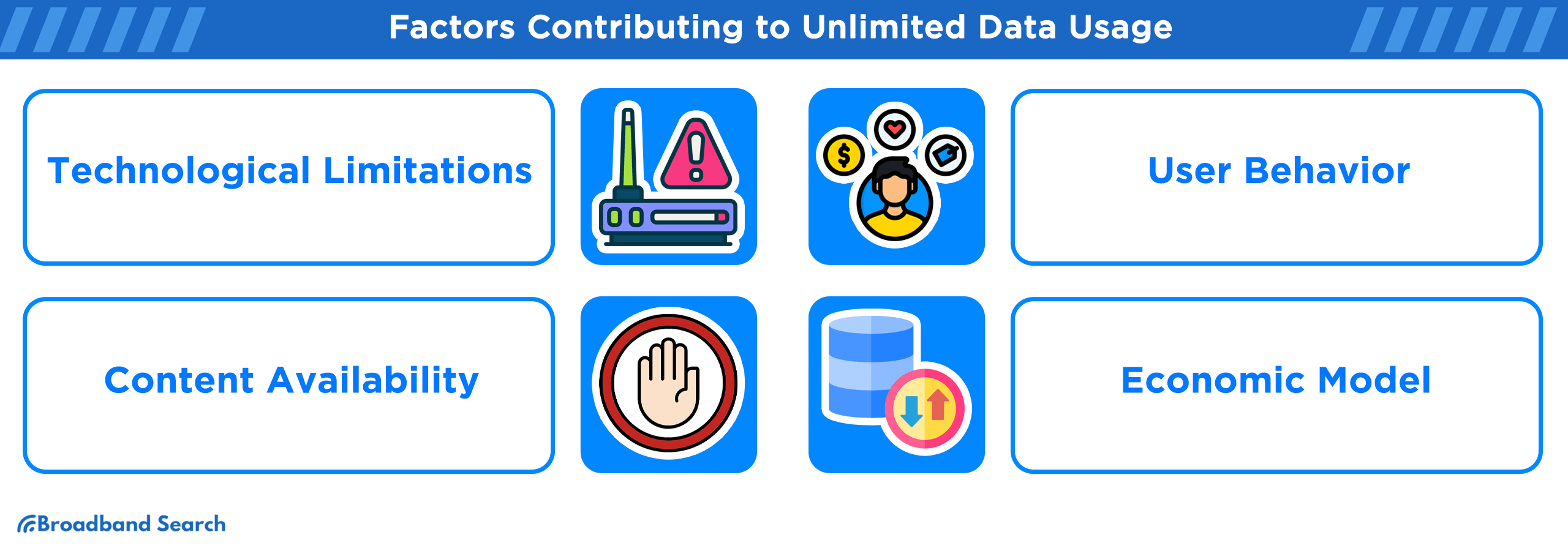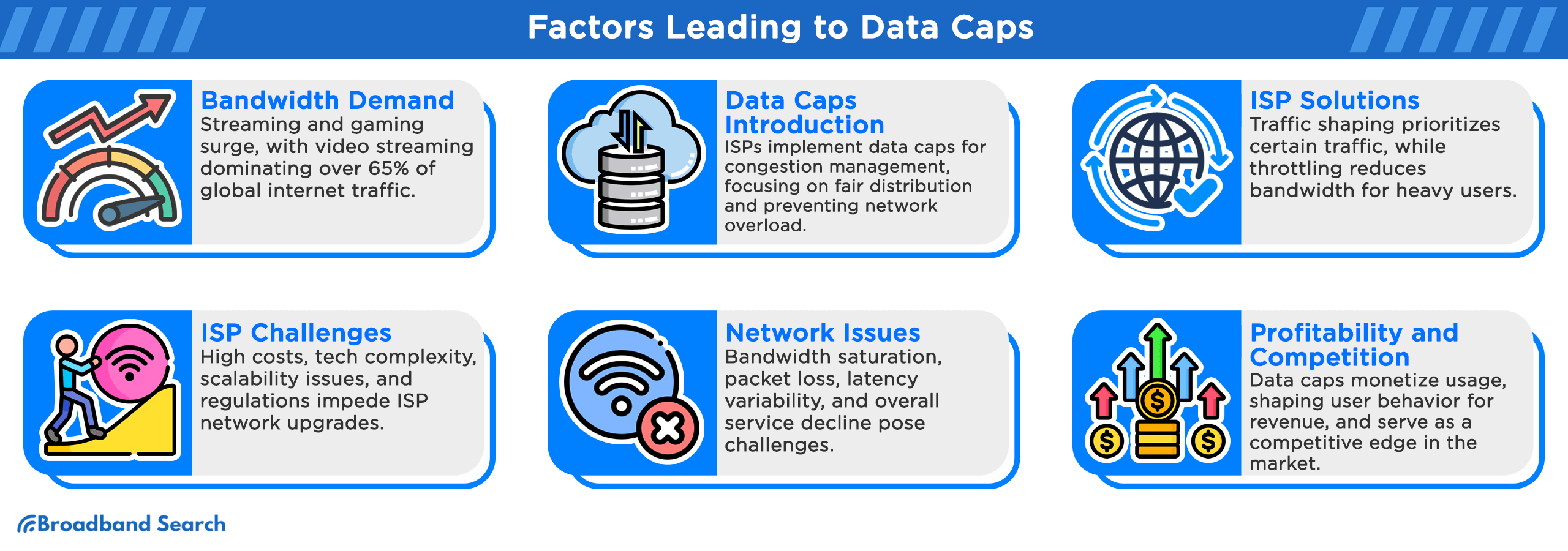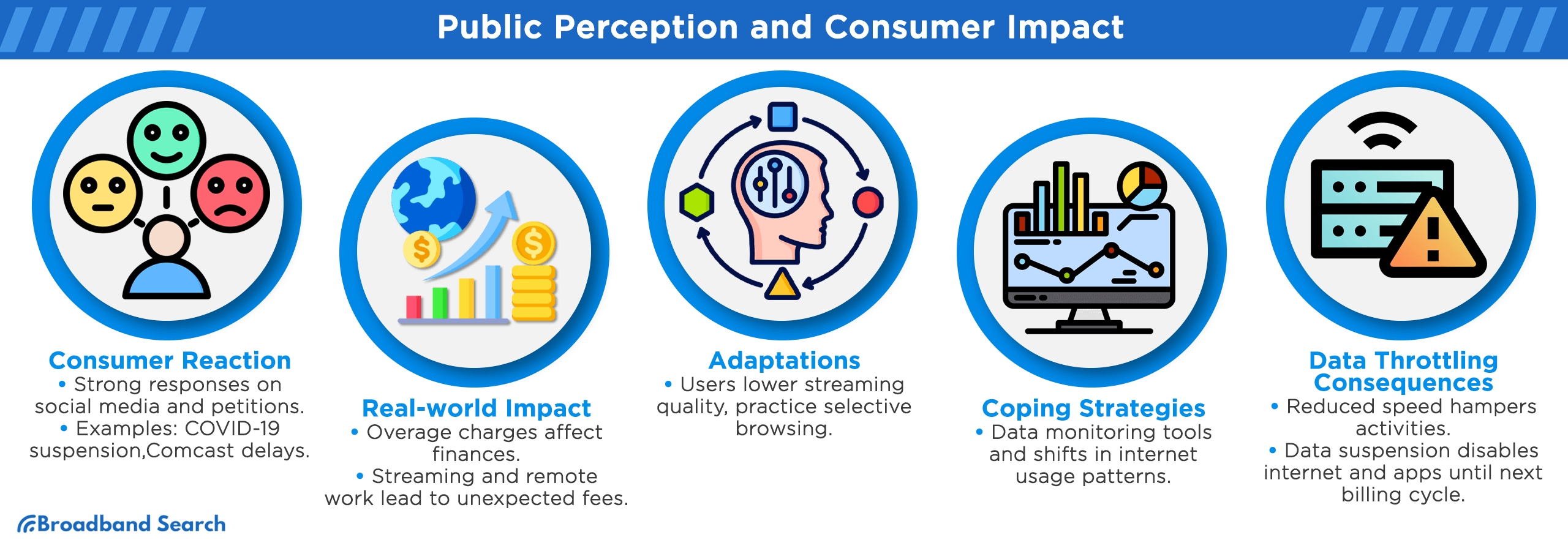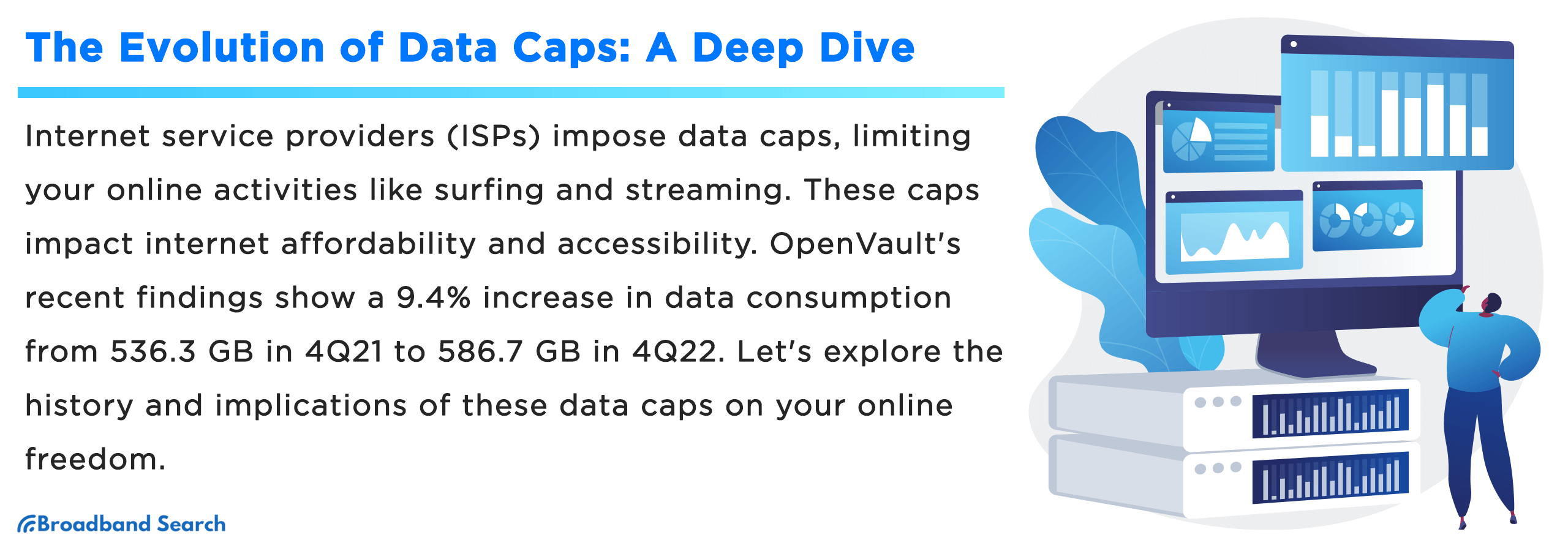Data caps, the upper limits to data usage imposed by internet service providers (ISPs), can shape (usually negatively) your online experience. They determine how much you can surf, stream, or download. Why do these caps matter? For starters, they affect internet affordability and accessibility, crucial in a world increasingly reliant on digital connections.
Curious about their origin and growth? Consider this: Recent findings by OpenVault reveal that in 4Q22, subscribers consumed 586.7 GB on average, a 9.4 percent increase from 4Q21's 536.3 GB. How did we get here, and what does it mean for your daily internet use? Let’s talk more about data caps, their history, and their impact on your online freedom.
Historical Perspective
Early Internet Usage
When consumer internet services emerged in the 1990s, dial-up connections were the norm. These connections operated over regular phone lines were notoriously known for their slow speeds averaging 56 Kbps. The sluggish pace meant simple activities like email and basic web browsing took considerable time.
Limited multimedia or interactive content was available, but took a long time to come by. Some might remember the times of waiting minutes for a single image to load or the dial-up tone. Those were the early days of internet access, vastly different from today's high-speed standards.
Initially, data caps were unheard of. Internet services were often provided at a flat rate with unlimited usage, reflecting the technological and economic landscape of the time. Here are four major factors contributing to the unlimited usage:

- Technological Limitations: The slow speeds of dial-up connections inherently limit data consumption. Users couldn't use large amounts of data quickly, even if they wanted to.
- Content Availability: The early internet had limited content, particularly in heavy formats like video or high-definition images, reducing the average data use per user.
- User Behavior: Internet usage was not as integral to daily life as it is now. People logged on less frequently and for shorter periods, primarily for email or basic browsing.
- Economic Model: ISPs compete primarily on access and speed, not data quantity. Unlimited access was a simple and attractive selling point for consumers unfamiliar with the internet.
Emergence of Broadband
The shift to broadband in the early 2000s marked a significant milestone in internet history. This move to faster, more reliable connections revolutionized how we interact online. Here are four major factors driving the adoption of broadband:
- Speed and Efficiency: Broadband offered dramatically faster speeds than dial-up, enhancing user experience and enabling more complex online activities.
- Increasing Digital Content: The growth in digital media consumption required faster download and streaming capabilities, which broadband provided.
- Falling Costs: As the technology matured, the cost of implementing broadband reduced, making it more accessible to a broader audience.
- Demand for Connectivity: The rise of online services and the increasing importance of the internet in everyday activities fueled a demand for better and faster connectivity.
Initially, broadband services were often marketed as unlimited, reflecting a continuation of the early internet's flat-rate approach. This was largely due to a few key factors:
- Consumer Expectation: Users accustomed to unlimited dial-up expected the same model to continue with broadband.
- Competitive Edge: Offering "unlimited" broadband was a key selling point for ISPs looking to attract customers in a rapidly growing market.
- Technical Feasibility: At the time, the average consumer's data usage was still relatively low compared to today's standards, making it feasible for ISPs to offer unlimited packages without significant strain on their infrastructure.
Factors Leading to Data Caps

Bandwidth Demand
There has been a nearly insatiable rise in bandwidth demand, driven by streaming, gaming, and other data-intensive services. Recent statistics show a huge increase in bandwidth usage, with video streaming alone accounting for over 65 percent of global internet traffic. The exponential growth in internet usage necessitates robust ISP networks, driving the Bandwidth on Demand (BoD) market to reach US$6.99 Bn by 2029.
ISPs face a multitude of challenges in upgrading their infrastructure:
- High Capital Expenditure: Upgrading to higher capacity networks involves significant investment in both technology and physical infrastructure.
- Technological Complexity: Adapting to newer, faster technologies requires continuous research and implementation, adding layers of complexity to network management.
- Scalability Issues: Rapidly growing demand means infrastructure must not only be improved but also scaled at an unprecedented rate.
- Regulatory Hurdles: Navigating the regulatory landscape can be challenging and time-consuming, often delaying upgrades and expansion.
In response to these challenges and to manage network congestion effectively, ISPs introduced data caps. At first, these caps were positioned as necessary for fair distribution of network resources and to prevent network overload. The early motivations were grounded in maintaining service quality across the network by discouraging disproportionate use by a minority of users. By implementing data caps, ISPs aimed to optimize network performance and ensure a more consistent and reliable service for all customers.
Network Management
ISPs faced the critical need to manage network congestion as internet traffic soared. Here are four technical aspects of network congestion and its impact on service quality:
- Bandwidth Saturation: When data demand exceeds capacity, speeds slow for everyone. This is like a highway jammed with too much traffic, leading to delays and frustration.
- Packet Loss: High congestion can result in data packets being dropped, affecting the integrity of data transmission and leading to retransmissions, further clogging the network.
- Latency Variability: Congestion can cause inconsistent latency, particularly detrimental for real-time applications like video calls or online gaming.
- Quality of Service Decline: Overall, congestion leads to a noticeable decline in the quality of internet services, affecting everything from browsing speed to streaming quality.
In response, ISPs considered alternatives such as traffic shaping and throttling:
- Traffic Shaping: ISPs prioritize certain types of traffic to maintain service quality, ensuring critical applications receive bandwidth priority. While effective for managing peak loads, it raised concerns about neutrality and fairness.
- Throttling: ISPs reduced bandwidth for heavy users or specific services. This method was straightforward but often unpopular, leading to a negative user experience and potential backlash.
As for profitability and competition:
- Profit Optimization: Data caps provided a direct way to monetize network usage, encouraging users to consume less or pay more for premium plans. This approach directly impacted ISP's bottom lines by creating new revenue streams.
- Competitive Advantage: In a crowded market, ISPs used data caps as a differentiator, offering various cap levels to attract different customer segments. It became a balancing act between offering enough value to attract customers and maintaining network quality and profitability.
Evolution of Data Caps
Early Implementation
The early implementation of data caps marked a significant shift in how internet services were offered. Initially, these data cap models were quite restrictive. For example, some of the first data cap plans imposed limits as low as 2GB per month, a stark contrast to what we see today. This period was characterized by experimentation, with ISPs testing various cap limits and pricing strategies to gauge consumer response and manage network resources.
However, the introduction of data caps wasn't met with open arms. The Communications Workers of America (CWA) and other consumer advocacy groups including Common Cause, Consumer Reports, Fight for the Future, and Public Knowledge voiced opposition against data caps. Key points of contention included:
- Restrictive Access: Consumers felt data caps unfairly restricted their internet access, especially as online content and services expanded rapidly.
- Transparency Issues: The main issues stemmed from prioritizing profits over user experience, creating artificial scarcity, and lacking transparency in data usage and billing. Providers enforced caps and overage fees, often with unproven fairness and congestion claims.
- Net Neutrality Concerns: Advocates argued that data caps could be used to prioritize or discriminate against certain types of data, undermining the principles of a free and open internet.
In response to the backlash and evolving market dynamics, ISPs began to refine their data cap policies. Changes in these policies reflected a more nuanced approach, considering both consumer satisfaction and network management needs. Key developments included:
- Increased Data Limits: Recognizing the growing data needs, many ISPs gradually increased their data cap limits.
- Introduction of Data Rollover Plans: Some providers introduced rollover plans, allowing unused data to carry over to the next billing cycle.
- Tiered Pricing Models: ISPs developed more sophisticated pricing models, offering various tiers of data caps to cater to different user needs.
Advances in Technology
The evolution of data caps has been significantly influenced by advances in technology, particularly in network infrastructure and data compression techniques.
- Deployment of Fiber Optics: Fiber optic infrastructure deployment sparked broadband growth beyond fiber-rich areas. Electric cooperatives, regional utilities, and existing frameworks have bridged the digital gap, especially in rural and underserved regions.
- Adoption of 4G/5G Networks: The rollout of 4G and later 5G networks dramatically boosted mobile internet speeds and capacity, facilitating higher mobile data usage.
- Enhanced Network Hardware: Upgrading routers, switches, and other network hardware allowed for more efficient data handling and distribution.
- International Data Links: Investing in undersea cables and other international data links expanded global connectivity, distributing traffic more evenly and reducing bottlenecks.
Advancements in data compression techniques play a critical role in optimizing data usage, which has a direct impact on the relevance and limits of data caps.
- Lossless Compression: Involves removing bits without losing information by finding and removing statistical redundancies, suitable for high-quality applications like databases, though it offers lower compression ratios (e.g., PNG format).
- Lossy Compression: Deletes unnecessary information to significantly increase compression ratios, used in formats like JPEG, but can lead to file quality degradation.
- Tape Compression: Tape vendors have improved compression for large archives, with formats like LTO achieving high compression ratios and offering substantial storage capacity.
- Hardware Compression: Modern storage hardware vendors universally include good compression capabilities as a standard feature, contributing to more efficient data storage and management.
- Data Footprint Reduction (DFR): Encompasses both compression and deduplication, with different techniques applied based on the type of data and application, leading to more efficient storage and transmission of data.
- Audio and Video Compression: With the rise of streaming, podcasts, and online videos, sophisticated audio and video compression techniques have become essential for managing bandwidth and storage constraints.
These advancements in data compression have allowed for more efficient use of data, thereby influencing ISPs to reassess and often relax data caps. As data can be compressed to smaller sizes without significant loss of quality, the volume of data that can be accommodated within a given cap has effectively increased, making data caps less restrictive and more user-friendly.
Public Perception and Consumer Impact

Consumer Response
The announcement of data caps by ISPs often sparked vigorous consumer reactions, from social media uproar to organized petitions. Users voiced their concerns about the implications for internet freedom and affordability, using hashtags and digital platforms to amplify their message. Consumer backlash has indeed influenced ISPs to adjust or reconsider data cap policies. For instance:
- During the COVID-19 Pandemic: Companies like AT&T, Comcast, and T-Mobile suspended data caps to eliminate fees for consumers, responding to increased internet usage and public demand.
- Comcast's Proposed Data Caps: Facing intense opposition from customers and lawmakers in the northeastern US, Comcast had to delay the implementation of their proposed 1.2 TB data caps until 2022.
Social media platforms and online communities were instrumental in this dialogue. They served as hubs for discussion, experience sharing, and mobilization.
Real-world Impact
Instances of overage charges due to data cap violations are not uncommon and have significant financial implications for consumers. Here are examples:
- Streaming Surprises: Customers often face hefty overage fees after a binge-watching session exceeds their data limit, leading to unexpected charges.
- Work-from-Home Woes: With remote work, individuals crossing data caps incur extra costs, disrupting budgets.
Data caps have also notably shifted consumer content consumption habits. In an effort to avoid overage charges, users are adapting by:
- Lowering Streaming Quality: Opting for lower-resolution streams to reduce data consumption.
- Selective Browsing: Prioritizing essential online activities and reducing discretionary data usage.
Faced with data limitations, consumers have employed various strategies:
- Utilization of Data Monitoring Tools: Many turned to apps and built-in device features to track their data usage in real-time.
- Changes in Internet Usage Patterns: There's a noticeable shift in how and when consumers use data-intensive services, with many scheduling downloads and updates for when they’re connected to unmetered networks.
Two consequences of data throttling that might occur when people go over their data cap are:
- Reduced Speed (Data Throttling): Exceeding data caps can result in significantly reduced speeds, hampering streaming, gaming, and social media while allowing basic browsing and email.
- Data Suspension: Hitting data limits can lead to complete data suspension, disabling internet access and online apps until the next billing cycle.
Future Trends and Speculations
Impact of 5G Technology
5G technology, with its promise of high-speed, low-latency connections, stands at the forefront of reshaping data consumption and potentially disrupting existing data cap norms. Here's how:
- High-Speed Connections: Real-world 5G significantly exceeds 4G, offering 3-6 times faster speeds generally, and even over 10 times in some markets. Widespread enhancement depends on infrastructure and spectrum availability.
- Low-Latency Communication: The significantly reduced latency of 5G improves responsiveness in real-time applications, essential for activities like online gaming or remote surgeries.
- New Usage Paradigms: 5G enables emerging technologies like augmented reality and autonomous vehicles, leading to new data usage patterns that traditional data caps may not accommodate.
The benefits of 5G extend to both consumers and businesses, including:
- Improved Streaming Quality: Users can enjoy higher resolution and more reliable streaming experiences without the buffering and quality issues associated with slower networks.
- Seamless Online Gaming: Gamers benefit from reduced lag and improved responsiveness.
- Efficient Remote Work: Enhanced video conferencing capabilities and faster data transfer rates make remote work more productive and less frustrating.
- Accelerated IoT Adoption: Faster, more reliable connections boost the performance of IoT devices, leading to wider adoption and more innovative applications.
- Emergency Services: Enhanced real-time communication can significantly improve responses in critical situations like natural disasters or medical emergencies.
However, the rollout of 5G also presents several challenges:
- Infrastructure Investment: Deploying 5G networks requires significant capital for new infrastructure, potentially slowing rollout in less profitable areas.
- Spectrum Availability: Effective 5G deployment needs access to suitable spectrum bands, which are limited and subject to regulatory approval.
- Device Compatibility: Consumers need 5G-capable devices to benefit from the network, necessitating upgrades that may be costly or slow to occur.
- Equitable Access: Ensuring 5G benefits are accessible to all, including those in rural or underserved areas, remains a challenge and a priority.
Possibility of Data Cap Alternatives
Let’s explore potential alternatives to data caps. Dynamic bandwidth allocation and Quality of Service (QoS) tiers emerge as top contenders in this arena.
Dynamic bandwidth allocation dynamically adjusts a user's available bandwidth based on network congestion. It ensures fair usage during peak hours and optimal performance when traffic is low. This approach fosters a more equitable distribution of resources.
Quality of Service (QoS) tiers prioritize certain types of internet traffic, like video conferencing or online gaming, over others during congestion. This ensures that critical applications receive the bandwidth they require, guaranteeing uninterrupted experiences.
Wrapping Up
The journey from stringent data caps to the possibility of their obsolescence reflects the internet's dynamic evolution. As technology propels forward and debates on consumer rights and equitable access rage on, the future of data caps hangs in the balance.
You should stay attuned to these changes, understanding that ongoing innovations and regulatory shifts will continue to shape the internet landscape, potentially leading to fairer, more user-centric data practices. The dialogue around data caps is far from over; it's just entering its next, most transformative phase.
FAQ
How do data caps affect different types of internet users, such as businesses and households?
Data caps significantly impact different user groups. Businesses, especially those relying on cloud services and data-heavy operations, face operational constraints and additional costs. Households often hit limits quickly, disrupting entertainment and work.
Are data caps consistent worldwide, or do they vary by country or region?
Globally, data caps vary widely. Some countries offer unlimited data as the norm, while others impose strict limits. Economic, regulatory, and competitive factors contribute to these variations, reflecting the diverse digital landscapes and policies worldwide.
How do data caps affect the development and adoption of emerging technologies and services, like cloud computing or 4K/8K streaming?
For emerging technologies like cloud computing or 4K/8K streaming, data caps pose a significant barrier. They can deter adoption or limit the benefits of these technologies, hindering innovation and the user experience, especially in regions with stringent data caps.
What are some strategies consumers can employ to monitor and manage their data usage effectively?
Consumers can manage their data through various strategies: using data monitoring tools to track usage, adjusting settings for lower data consumption, scheduling heavy downloads for off-peak times, and choosing more efficient streaming options.
What role do regulatory bodies play in monitoring and enforcing data cap policies?
Regulatory bodies like the FCC ensure transparency, fairness, and address consumer complaints while also adapting regulations to reflect technological advancements and market changes, ensuring consumer interests are protected.

